Last weekend Bob and I went to Pickerington Ponds to see if the Great Blue Herons had resumed nesting there. Great Blue Herons like to have their nests grouped together, so it is sort of like they’re living in an apartment complex. If no more nests will fit in a particular tree, then herons will nest in the tree next door. This grouping of nests is called a heron rookery or sometimes a heronry, and herons are said to be colonial nesters.
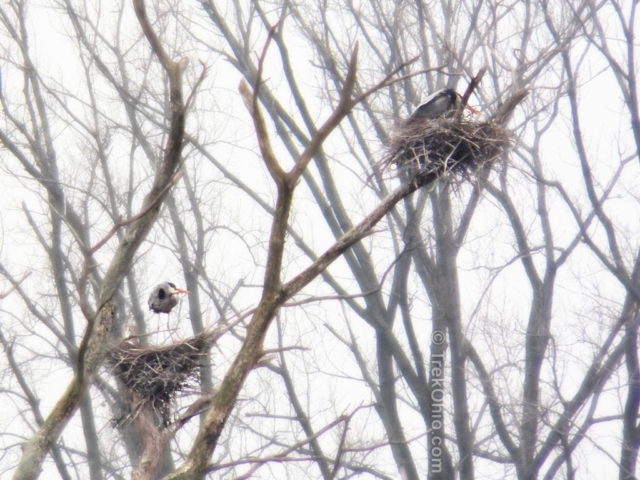
This tree had four nests so far, but not all four were occupied while we were viewing them.
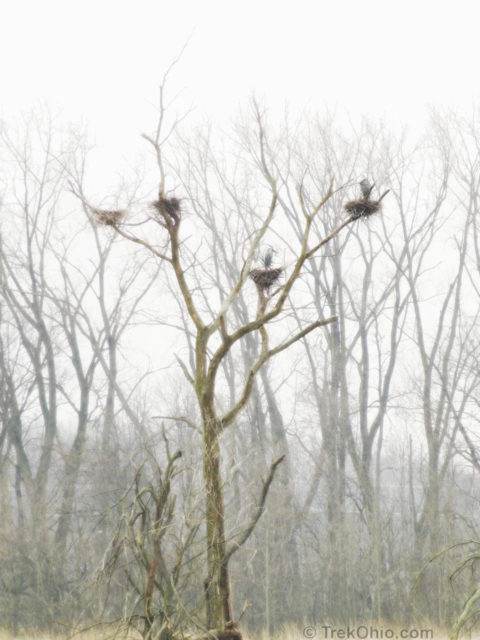
We saw one heron in a nearby nest who was lying down and seemed to be incubating eggs already.
Since we’ve been to this same heron rookery in previous years, I can give you some idea of what it is like later in the season. The photos below are of the same tree, but were taken May 8, 2011.
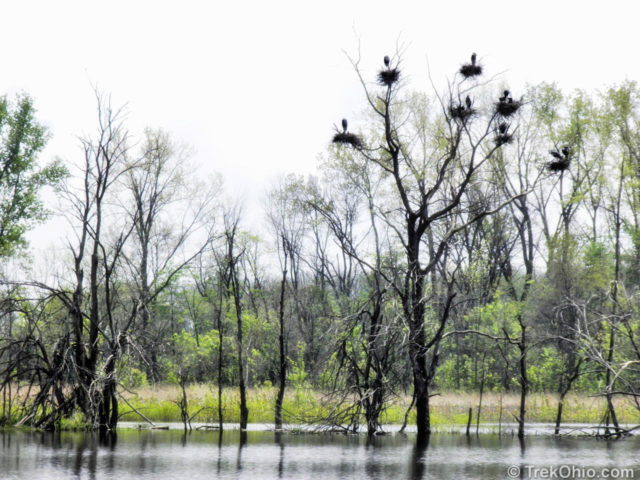
Although the photos below are stretching the telephoto capability of our point-and-shoot cameras, they give you some idea what the nests are like once their eggs have hatched.
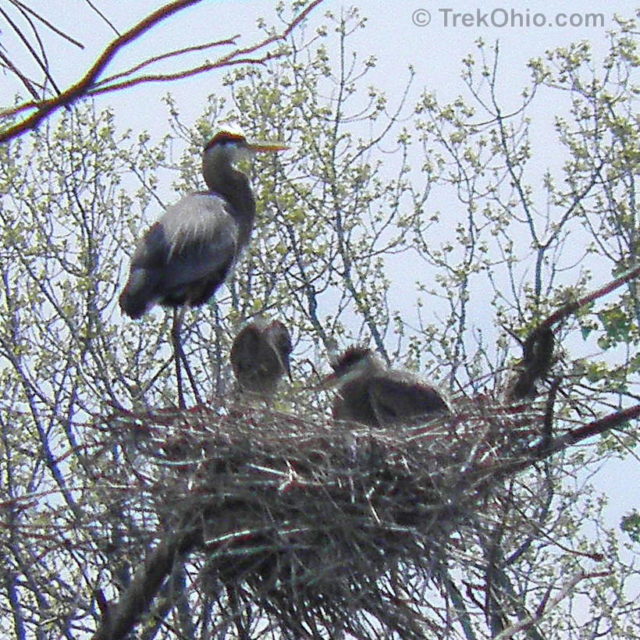
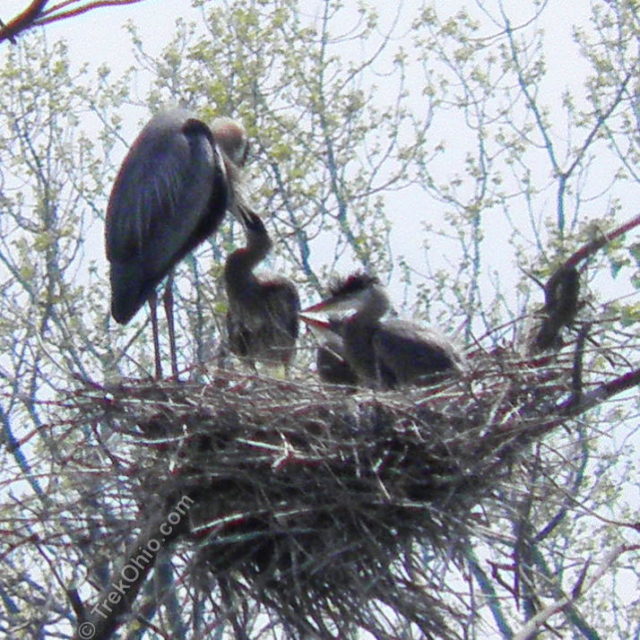
One of the joys of going bird watching for great blue herons is that they are so large it’s hard to miss them. They are four feet tall (about 1.3 meters) with a wing span of seven feet (about 2.3 meters). Although a few herons remain here all year long, most migrate because they need unfrozen water to fish. The males typically return first, so they can pick a nesting site. The females return a few weeks later. Once they have paired up, the male continues to strengthen their bond by presenting his lady with sticks for their nest. This gift-giving goes on from February through April. The male and female take turns incubating the eggs during the 28 days it takes before the eggs hatch.
The females lay 3 to 7 eggs which hatch in late April or early May. The young birds can be viewed in their nest for about 60 days. The youngsters usually fledge (learn to fly) in July. They vacate the nest soon after.
The nests are four feet wide and about two feet deep; they’re lined with soft material like leaves and moss. Herons often re-use nests year after year.
If the youngsters make it through their first year, they have a chance of living for twenty years.
If you go to a heron rookery, I recommend that you take binoculars or a spotting scope if you have one available. Although the nests may be some distance from where you are standing, you can often see individual great blue herons much closer while they are hunting for food. They typically stand very still and wait until prey comes close enough to ambush it. Here’s a photo of one laying in wait in a stream at the Pickerington Ponds Metro Park.

The only heron rookery that I’ve personally been to in Ohio is the one in Pickerington Ponds. But I searched the Internet to find a number of other heron rookeries across the state. The list of other heron rookeries follows the information on Pickerington Ponds below.
Locations of Heron Rookeries in Ohio
- Pickerington Ponds
- featured in this post; see Location below.
- Smith Preserve at Olentangy Falls
- (Delaware County in a Liberty Township preserve): This is on Taggart Rd., just south of the intersection of Taggart Rd. and Hyatts Rd. (GPS: 40.213053,-83.057835). I published an article on this heronry, Heronry in Delaware County.
- Lake Hope
- (Vinton County): According to Lake Hope State Park Bird Watching Guide-Ohio Valley Birding Trail
The wetland area along SR 278 and ¼ mile south of the Lake Hope dam contains a large Great Blue Heron rookery of about 50 nests.
- Winton Woods
- (Hamilton County, near Cincinnati; click to see the location on Google Maps): I believe you can get directions as to the heron rookery’s location from Winton Center which houses the park district’s administrative offices; phone number is (513) 521-7275.
- Church parking lot in Mason, Ohio
- (Warren County): According to this post on Flickr:
This GBH rookery can be seen just north of downtown Mason, Ohio. The nice folks at the Living Leaf Community Church on Rt 42 allow everyone to use their parking lot and view the colony from the fenceline between the trees and shrubs. This gives a great view of the heronry without disrupting the nesting.
- Morrow,Ohio
- (Warren County): I believe that this heron rookery has become a preserve managed by a conservation group called, The Little Miami, Inc. According to this PDF file it is a 147 nest heronry, one of the largest in Ohio. You might be able to walk or ride a bike to the heron rookery since the Little Miami Scenic Trail looks like it goes right by it (Trail Map –PDF). In addition there is canoe livery that offers tours that pass the heron rookery.
- The Rookery
- (Geauga County, located at 10110 Cedar Road, Munson, OH 44026; click for location on Google Maps):
The Rookery is a 562-acre tract located in southwest Munson Township. The Chagrin River, the old Interurban Railroad Junction, and one of Geauga County’s largest nesting colonies of great blue heron are all special features of this park. It is Geauga Park District’s intent to protect this natural area in perpetuity.
- Grape Island in the Ohio River Islands National Wildlife Refuge
- (West Virginia on the other side of the Ohio River): Location on Google Maps
- Cowan Lake State Park
- (Clinton County, between Cincinnati and Columbus): the heron rookery is located off State Route 730
- Estel Wenrick Wetlands
- (Clark County, Ohio):
In early spring, a large heron rookery at the Wenrick Wetlands is visible from Spangler Road. Sixty blue heron nests and a Cooper’s Hawk nest rest in the branches of two large trees.
- Cuyahoga Valley National Park, also known as Bath Road Heronry
- (Summit County on Bath Road, between Riverview and Akron-Peninsula roads, near Akron, Ohio): There is a pull-off along Bath Road for viewing the heronry at the point located on this Google Map.
- Narrows Heronry
- (Summit County): This may be the same heronry as the Bath Road Heronry immediately above. It’s GPS coordinates point to a location to the south of the pull-off for the Bath Road Heronry. Here is its location on Google Maps. Update: I was just looking at this Google Map image again. Surprisingly if you zoom all the way in you can actually see the shadows cast by the heron nests.
Additional information
- Wikipedia: Great Blue Heron
- ODNR: Great Blue Heron
- ODNR: Riparian Corridor Birds
- Red and the Peanut: Great Blue Heron Heronry
- TrekOhio: Franklin County Parks & Nature Preserves
- TrekOhio: Fairfield County Parks & Nature Preserves (Pickerington Ponds is located in Franklin & Fairfield counties)
Location of the Heron Rookery at Pickerington Ponds
The address for Pickerington Ponds Metro Park is 7680 Wright Road, Canal Winchester, Ohio. However the park is 1600 acres, and it can be hard for a person new to the park to find the heron rookery. In the map below I have identified where to park to view it. You can get directions by viewing the larger map at Google. If you enlarge the map you’ll see that there is a line of trees going from left to right across the middle of the map. This is where the heron colony is nesting. There is a multi-use path around the wetland, so if you like you can walk around and view the nesting areas from other angles.
When you get to the parking lot, you’ll see a fenced-in grave. This is the grave of an Ohio settler; it was common for people to be buried on their farms during this period.
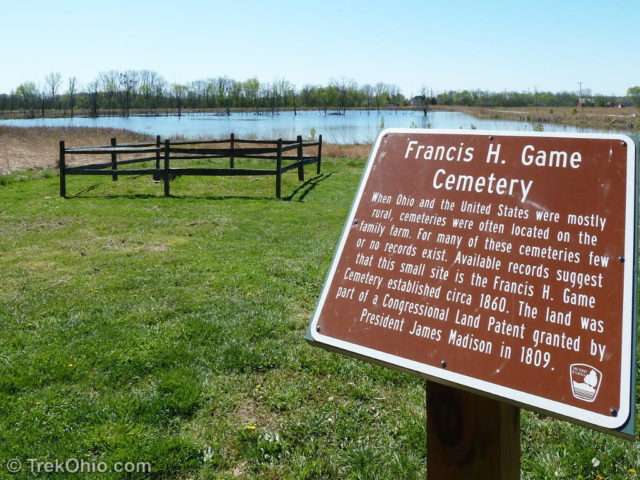
More on Birds
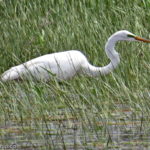
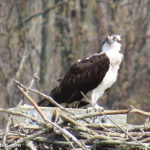
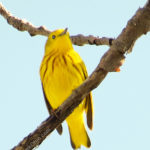
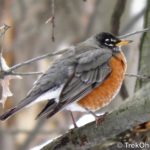
I live right by Smiths Preserve in Liberty Township (right by the Olentangy River). Looks like the herons just made it back. Spotted 7 or 8 of them in the river the other day. Great to see them again!
Thanks, nice to see. From the dates above this may too late, but here goes. Trumbull Co, Howland township mosquito creek watershed wetlands. New nesting visible from north river rd across the street from the townships public works along the creek. Also older one in the wetlands to the south. Unfortunately teenagers with shotguns thought it fun to shoot them apart ( left one dead on ground) I pleaded with twnshp official to do something about it.(they control this very large and beautiful area, but they don’t seem to care.
Wonderful post for a lovely bird… We’ve been seeing failing nests and young here, for some reason. It’s been reported, but fortunately they’ve tried, tried again! 🙂
Thanks, FeyGirl. I can’t help but wonder what’s going on with the failing nests, but I’m glad to hear that they just keep trying. On our site’s Facebook page we have posted a photo that someone shared of a bald eagle nesting in the middle of a heronry. How surprising is that?!?! The person who shared the photo (Sherry) believes this hasn’t spooked the herons. She is going to try to go back soon, and I’m really interested in hearing how this develops.
WOW, how interesting!! I know that they can be lone nesters…. Perhaps they couldn’t FIND a more viable location? A safer one, that is?
I too hope this is a rare occurrence — there have been many theories, of course. I hope it’s not human-related.
I could be wrong, but maybe it’s actually a good sign. I could be that the population of eagles in Ohio is growing at such a clip that they are infiltrating new areas. A Facebook contributor, Sherry, has returned to see if the eagles and herons really are sharing the same tree. It turns out that the eagles did scare away the herons, but they didn’t scare them that far away. The herons are just down the road a bit now.
That’s really interesting…. And it would be a great sign! Wow. Very interesting.
What a wonderful post with great photos. Herons are quite rare yet today in Finland there are certainly about 80 herons, but possibly more.
Unlikely that they are they are Blue Heron, which are North American birds (though I understand a few occasionally get very lost and end up in the Azores or Spain). Looks like the Grey Heron live in southernmost end of Finland (map).
Oh wow! What a great post!. There’s a Heron Rookery Nature Preserve called Lake Renwick not too far from my home. You just reminded me …. going there is on my list of things to do!
I’m glad that you liked the post. 🙂 Last year I checked the local rookery early, and then when I went back to see it with babies in the nest, they had already fledged. DOH! I need to remember to go back earlier this year.
used to see these east of here-thanks for sharing because it is an exciting thing to see.
Your welcome, Jane. 🙂
I go to the bath road rookery when I get a chance last couple of years I missed them this time I go I will have a better camara. I see them around here all year long, they like hte guys big pond across the street, you can’t see the pond because there are alot of trees, i see them at firestone park in akron all year, sometimes I can watch several of them fly from this pond in the spring over my head in 2 and 3’s. latly I have been seeing alot of osprey too at the arlington road home depot in akron, there is a huge nest on the cell tower and last year they had a babies in there, you can barly see it without binoculars. really neat birds.
I’ve heard that osprey are partial to nesting on cell towers. There is another blogger here at WordPress (Donna) who has photographed some osprey nesting on a freeway sign, too. Seems like an unappealing nesting area to me, but what do I know. Maybe the population has grown so much that there aren’t enough nesting platforms for them now.
My daughter is going to Kent State University. Perhaps when I am visiting her I can make time to check out the Bath Road rookery or Firestone park.
This is another very interesting post. You do your homework and pass the goodies on to us. It is very much appreciated. There is a rookery along Route 303 here in Lorain county and at marginal road entrance along Route 2 near Sandusky. You can see many blue heron along the road down Route 2 as you head toward the Ottawa National Wildlife Refuge and Magee Marsh. To get a good view of them and their nests you need to have the right equipment. What I find is it is hard to position yourself for taking photographs because their nesting areas are not very accessible. Do you know what the similarity is between the egrets and herons it seems they like the same habitat.
Thanks, Patricia. And thank you for pointing out another heron rookery. We only see egrets in central Ohio while they are migrating through the area. When they are in the area, they seem to like fishing in the same shallow mudflats as the heron:
I love watching birds, but I don’t really have sufficient telephoto on my camera to photograph them unless I get lucky and see them fairly close. I have heard of some people doing “digiscoping” where they mount their cellphones onto a spotting scope to do bird photography.
…. Great post, ma’am. And a great bird, too. Down here in Florida, we’ve noticed a larger number of failed nests this year. On the other hand, the bulk of the rookeries are in inaccessible areas beyond human interference. …. What’s really cool about the heron “condos” is that a number of other birds will roost in the lower branches. A tree is generally safer when a 4′ tall monster is guarding it!
Thanks, Jimbey. Speaking of other birds roosting in a heron rookery, on our Facebook page someone shared a photo of a bald eagle nesting right in the middle of a heron rookery. I thought that surely this had scared off the herons, but I’m hearing that they are still there.
So interesting and great pictures! I didn’t know about most of the other rookeries–thanks for the info!
Your welcome, Deb. It was interesting learning where some of the other heron rookeries are. If I’m in the area of any of these while the birds are still nesting, I’ll try to stop by.